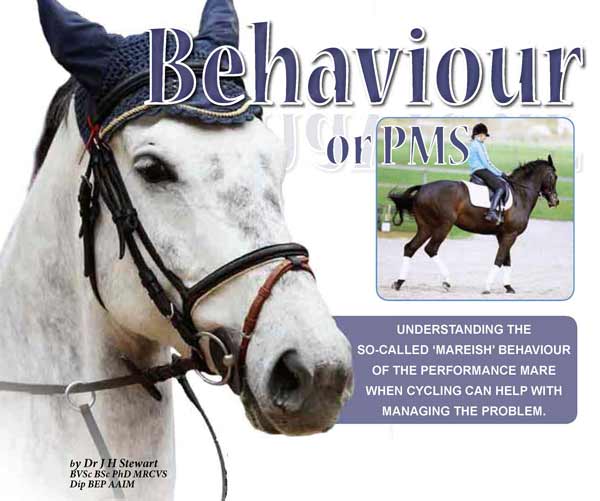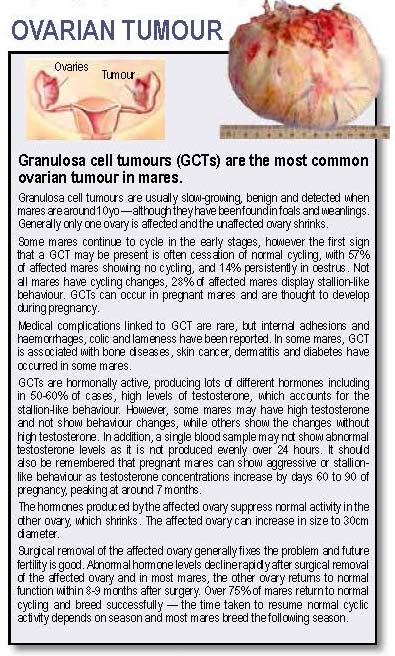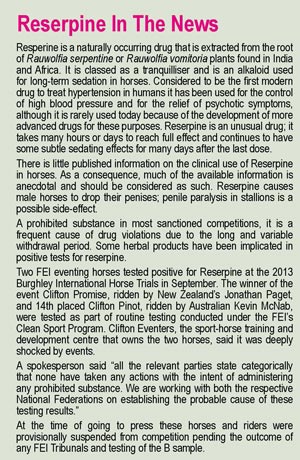|

Before labelling all abnormal behaviour by mares as ‘PMS’ (Pre Menstrual Syndrome) it is important to consider that bad, aggressive or unacceptable behaviour, which is limited to under saddle work, very often means pain. Undiagnosed pain can cause horses to become very nervous, swing around, buck and show other strange behaviours, including reluctance to approach hills, therefore making a lameness examination an essential part of the diagnostic work up.
Aggressive behaviour is more pronounced in what is known as an ‘alpha mare’. These are the born leaders who can be very difficult to work with because their instincts drive them to be the boss and establish order around them. In a herd situation it is the alpha mare that determines who goes where and when. However, in a stable or paddock situation, she has no power to control the activity around her and this can be very unsettling. In fillies, social isolation can cause anxiety and handling difficulties. In both these situations, changes in routine and management are the best approaches.
Nutritional deficiencies can also contribute to difficult behaviour and, depending on the horse’s diet, imbalances in calcium and/or magnesium and vitamin B may be involved. Other symptoms of calcium-magnesium imbalance include a high sensitivity to touch and sound, abnormally high muscle tone, muscular twitching, nervousness, touchiness, irritability, ‘temper’, muscular cramping or tightness and tying-up.
Gender factors exert their effect via hormones, but hormone problems, unrelated to PMS, can cause aggressive behaviour. The ovarian follicle is found in the ovary and is the basic unit of female reproduction. These structures are periodically initiated to grow and develop and culminate in ovulation. If a mare has multiple follicles or a persistent large follicle, this will keep her in a state where she constantly shows ‘heat’.
A note on signs of ‘heat’ - squirting urine is not 100% reliable as a sign - young fillies can do this when excited or angry. Persistent follicles are not uncommon in young fillies/mares and may persist into winter, with the behaviour occurring regardless of activity. A veterinary examination followed by a single hormone injection usually resolves these problems.
Some fillies and mares are overly aggressive because of excess testosterone. This can come from a granulosa cell tumour on the ovary or can be present without a tumour. A veterinary examination and blood test for levels of testosterone is the way to go here. Mares may also develop tumours called cystadenomas – detectable by ultrasound examination.
The Effects of Hormones on Behaviour
What are the effects on behaviour of cycling female hormones and when do they present as a problem? Oestrogen is the ‘feel good’ female hormone. It is anabolic ie body building and boosts immunity. In horses it is highest immediately a mare or filly begins to show ‘heat’ and remains high while she is showing signs. During this oestrogen phase there is often improved performance and a longer time to exhaustion. There is the odd mare or filly who is difficult when she is in oestrus but the majority of them are actually at their best in the week or so before they start showing oestrus.
The horses that are sensitive to touch/sound and are ‘jumpy’ in general may have diets that are low in magnesium, therefore supplentation may help.
‘Heat’ or oestrus can affect performance, especially in young fillies where hormone swings may be greater, their effects more intense (she has other things on her mind) and there can be an element of discomfort for the filly around the time of ovulation, when the egg is released - it may look like she has a sore back, or that her hocks are bothering her and she may be very touchy in the flanks. A big part of this is immaturity and many do indeed grow out of it. Young mares are prone to colic as a result of entering puberty and/or cycling and yearling fillies need special attention in terms of nutrition and exercise. Social contact is especially important at this age for fillies’ psychological well-being and normal behaviour. In addition, yearlings with 24 hour pasture access have increased bone density and reduced incidence of developmental bone diseases, compared to confined yearlings and yearlings at pasture for 12 hours a day.
Diet and Nutrition
Dietary factors do affect hormone fluctuations: Vitamin B6 adjusts the way a diverse array of hormonally responsive genes cause the horse to behave. For mares and fillies in work, the demand for B vitamins increases due to stress and training. This demand can exceed intestinal production and this should be suspected if a mare has loose manure/diarrhoea when excited. Ensuring vitamin B6 and thiamine intake are adequate is especially helpful with nervousness. Whilst pharmaceutical intervention can block the signs of oestrus, if the issue is behavioural, magnesium and B6 may get the job done just as well, if not better.
Magnesium (30 to 50 grams of magnesium oxide powder) and vitamin B6 (600 to 800 mg/day) work well for fillies with negative mood swings, who are sulky, aggressive or just want to be left alone. Specific research into the effects of high vitamin B6 intake shows similar effects across the board - decreased sensitivity to both sex and stress hormones.
Most equine diets are too low in magnesium and the horses with responsive behaviour problems (sensitive to touch/sound, ‘jumpiness’ in general) are sensitive to the low intake. A major difference between the availability to the body of various organic and inorganic forms in humans versus horses is that people have low fibre diets and dissolving inorganic salts within the intestines is a critical factor. In horses, the extensive fibre fermentation in the caecum and colon makes absorption of minerals from these areas a much more important source. Magnesium levels are inversely related to oestrogen levels - i.e. high oestrogen, low magnesium, low oestrogen, high magnesium. The highest oestrogen levels occur at the times of oestrus/heat and this may at least partially explain why some fillies seem more prone to tying up and muscular soreness at this time. If the diet is magnesium-deficient, or the amount of calcium is way in excess of the magnesium, horses often show an unusually high resting muscle tone, even some spontaneous muscular fasciculation. Supplementing magnesium to a level that brings the ratio of Calcium to magnesium (Ca:Mg) in the total diet (hay, grain, water, supplements combined) to the range of 2:1 to 1.5:1 will correct the imbalance.
Drugs and Other Therapies
Drug therapy for PMS in horses includes progesterones and although these suppress strong signs of oestrus, they can have a negative effect on attitude. Mares often become dull and sulky when left alone but just as aggressive and touchy in work, and if used for fillies that are ‘mean’, it often makes them even ‘meaner’ - although they won’t show signs of heat any more. For this reason, these drugs should be used selectively and only at strategic times during the cycle. The best way to determine if progesterones might help is to monitor behaviour over several cycles, noting when the mare works best using solid measurements of performance, not necessarily how easy she is to work with or how much urinating she does.
Reserpine is marketed as an aid in calming horses and seems to work very well in some horses but not very well in others. It acts by depleting neurotransmitters in the brain, particularly serotonin, apparently resulting in ‘subtle changes in behaviour that may only be observed by those very familiar with the horse’s normal behaviour’.
Obviously the drug cannot be used in horses that are competing, as it is a prohibited substance, and although some people find it a useful training aid, there are reports that it produces ‘sedation to overt depression,’ and there is some concern about the effect in horses that are being ridden.
Alternative therapies include herbal preparations and pheromones, a chemical substance animals release into the environment, which affects the behaviour or physiology. This was a relatively new development (at the time) and the use of pheromones was presented to equine veterinarians attending the national conference of the American Association of Equine Practitioners (AAEP), November 2003. Pheromones are picked up by an organ in the nose that transfers them directly to receptors in the brain. In mammals, lactating females release substances referred to as ‘appeasing’ pheromones, the function of which is to calm and reassure the offspring. Research has shown that horses recognise these pheromones throughout life. These maternal pheromones can be found on the skin in an area called the ‘wax area’, which is close to the udder of a mare that is suckling her foal. When a horse inhales these calming pheromones, they settle on receptors in the nasal cavity producing a reaction that calms the animal.
Awareness of hormonal changes, evolution and the fundamental pre-requisite of a balanced diet underpins the management of horses. Combining a sound basic diet with behavioural knowledge helps humans in understanding the important relationships that affect behaviour.  |